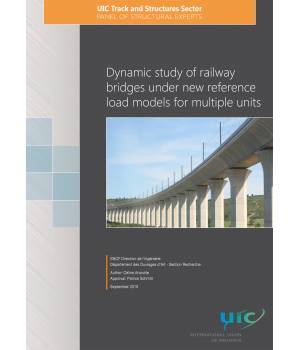
Dynamic study of railway bridges under new reference load models for multiple units
This paper presents the different stages of the study and the obtained results:
• Creation of the RLM: the real trains were first sorted by their characteristics
and gathered into families. Reference Load Models were then created in order to
represent and cover the dynamic excitation of all the trains in the different families,
each characterised by ranges of parameters. The RLM and the associated
ranges of train parameters were transmitted to the rolling stock manufacturers
for them to bring their feedback.
• Calculations on real bridges: a first calculation on a real bridge (filler beam
bridge on classical line) allowed to get direct feedback on the RLM. Three of
them were modified to better cover the behaviour of the bridge under the real
trains. The next calculations on real bridges were made with the 8 initial and the
3 modified RLM.
• Parametric study: in order to have a more general overview on all the types of
bridges, it was necessary to undertake a parametric study. Ranges of spans,
frequencies and masses were chosen to perform the calculations on a simply
supported beam. The results of the parametric study were postprocessed to get
an idea on which types of bridges were more sensitive than others.
| Author | UIC - Rail System Department |
| ISBN | 978-2-7461-2642-8 |
| Pages | 124 |
Data sheet
- Language
- English
- Format
- Downloadable
- Edition
- Ed. no.1
- Edition date
- 01/09/2015
- Publication date
- 03/08/2017
- Page number
- 124
- Theme
- Infrastructure Train track interaction Infrastructure Interaction train/voie
- sku
- 1-17006E-PDF
- Reference
- 1-17006E
 Cookie preferences
Cookie preferences

